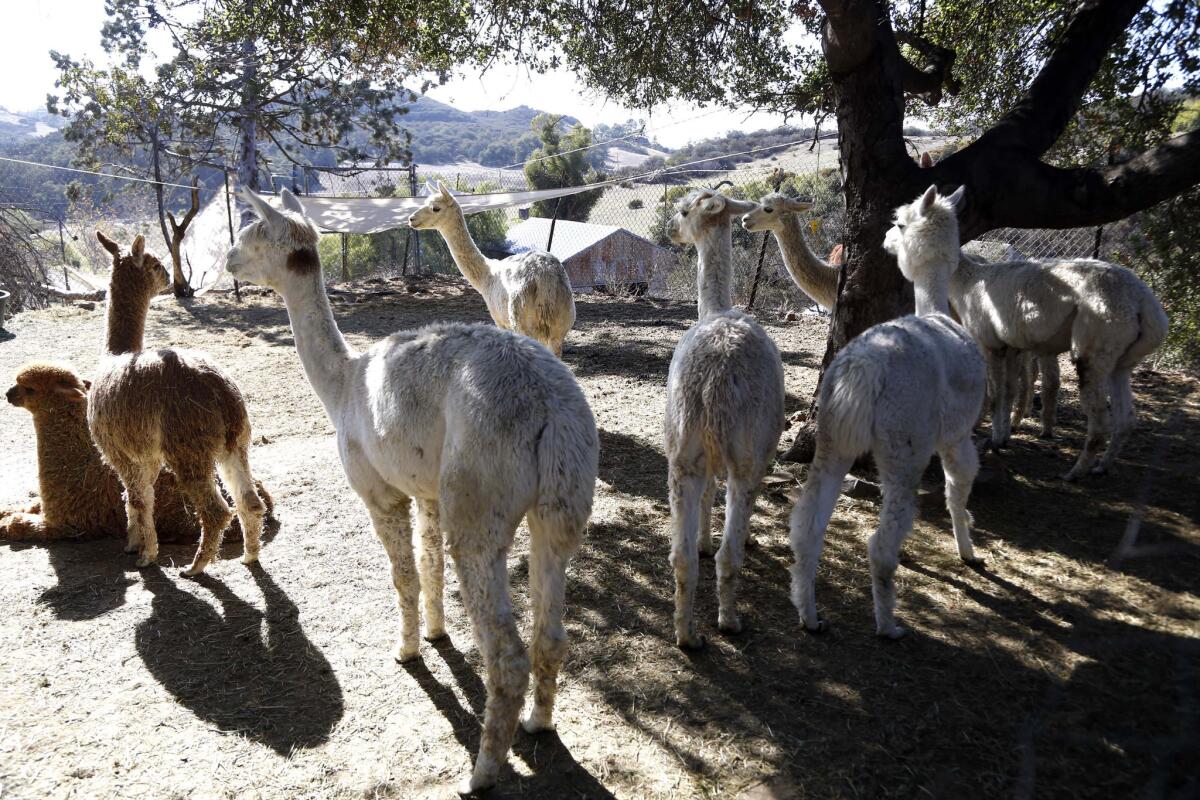Op-Ed: P-45 doesn’t deserve to die, and neither did the 10 alpacas he killed

P-45, the Malibu mountain lion who spent last week on death row, has received at least a temporary reprieve. After he killed 10 alpacas in one night, having already killed around 60 domestic animals in the last two years, a Malibu resident acquired a permit to shoot him. But public outcry, including a petition signed by thousands, has persuaded her to hold off.
Although I’m an animal rights advocate, I have yet to sign on. The petition, while suggesting the landowner find “other solutions,” did not offer any.
When a charismatic animal’s life is at stake, we sometimes lose sight of the big picture. To begin with, there is a surprising lack of public sympathy for the woman who lost 10 beloved alpacas in one night, and for the defenseless, llama-like creatures who were unable to flee a mountain lion behaving less like a hungry predator than a killing machine.
The sad truth is that wild carnivores are routinely exterminated for killing a single farm animal — let alone 10 in one night — or just for being judged a threat. Last year, the federal Wildlife Services agency killed 3.2 million animals regarded as pests by farmers and ranchers. In fact, government agencies may kill any animal seen as a possible danger to humans, as was the case last week in Pennsylvania, when a bull escaped from a slaughterhouse and was shot by a game commission officer. In 2012, police in downtown Santa Monica shot and killed a mountain lion for the crime of showing up.
If we don’t want P-45 added to that toll, we need a realistic solution. I haven’t seen one.
This newspaper reported that a group of wildlife advocates flooded P-45’s recent feeding ground with multicolored light to ward off the animal and “save the lives of big cats, livestock and pets, all at once.” But won’t bright lights on one ranch drive him to another? It seems impractical to suggest that all Malibu ranch owners illuminate their properties all night every night.
Some have floated the idea of relocating P-45 in the Santa Monica Mountains. But now that he has experienced the simple joy of finding prey behind a fence, like a conveniently boxed lunch, we can expect him to seek out more of the same.
There is also talk is of placing P-45 in captivity — an option he would be unlikely to support, if he had a say. Large predators rarely have good lives in zoos or sanctuaries, where they are unable to do what they like to do best: hunt prey. We might compare their plight to humans jailed for no crime, except that mountain lions cannot watch TV, work out, read, consult law books to aid their counsel or begin work on their memoirs. Many of us, perhaps including P-45, would prefer a quick bullet to a long life in the hole.
From the utilitarian perspective, moreover, big cat sanctuaries are problematic. Not only are the residents unlikely to experience true well-being, but feeding them causes immense suffering and death. A carnivore in a sanctuary eats hundreds of herbivores every year who have been raised on factory farms.
Sometime in the future we’ll grow large quantities of meat in vats, generated from cells rather than suffering animals. Perhaps sooner, sanctuaries can add taurine, an amino acid needed by cats, to products such as Beyond Beef, which have a similar protein content to meat and are becoming increasingly difficult to distinguish from it. Until such alternatives are employed, though, sanctuaries for large carnivores will hurt exponentially more animals than they help.
Yet another proposal is to manage the prey, rather than the predator. After P-45’s reprieve, NBC reported that wildlife experts recommend keeping livestock “in some sort of enclosed barn or shed.” For how long? Forever? Why should hundreds of animal owners condemn many thousands of innocent animals to lives of misery to protect one extraordinarily lethal cat?
We should never kill animals lightly. I’m not on board when people wish to kill coyotes who kill cats who kill birds all day, and I find it abhorrent that Wildlife Services slaughters millions of carnivores every year, as a gruesome subsidy of sorts to ranchers. But with no practical, humane alternatives on offer, I can’t fault the heartbroken Malibu resident who acquired a shooting permit after waking up to profligate carnage.
Karen Dawn runs the animal advocacy website and nonprofit DawnWatch, and is the author of “Thanking the Monkey: Rethinking the Way We Treat Animals.”
Follow the Opinion section on Twitter @latimesopinion and Facebook
More to Read
A cure for the common opinion
Get thought-provoking perspectives with our weekly newsletter.
You may occasionally receive promotional content from the Los Angeles Times.










